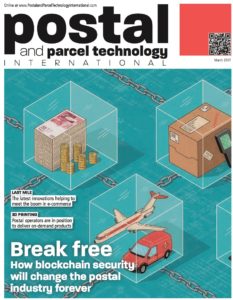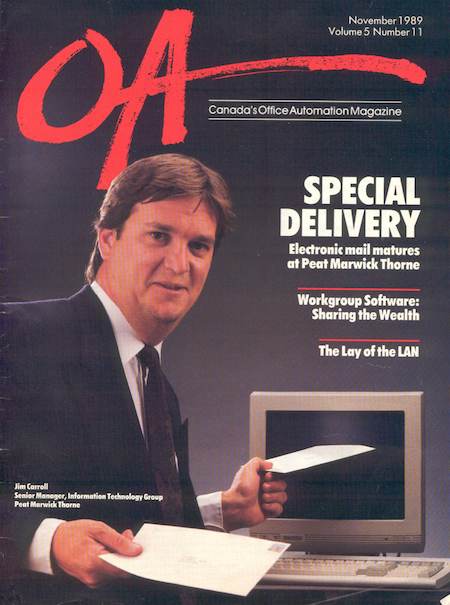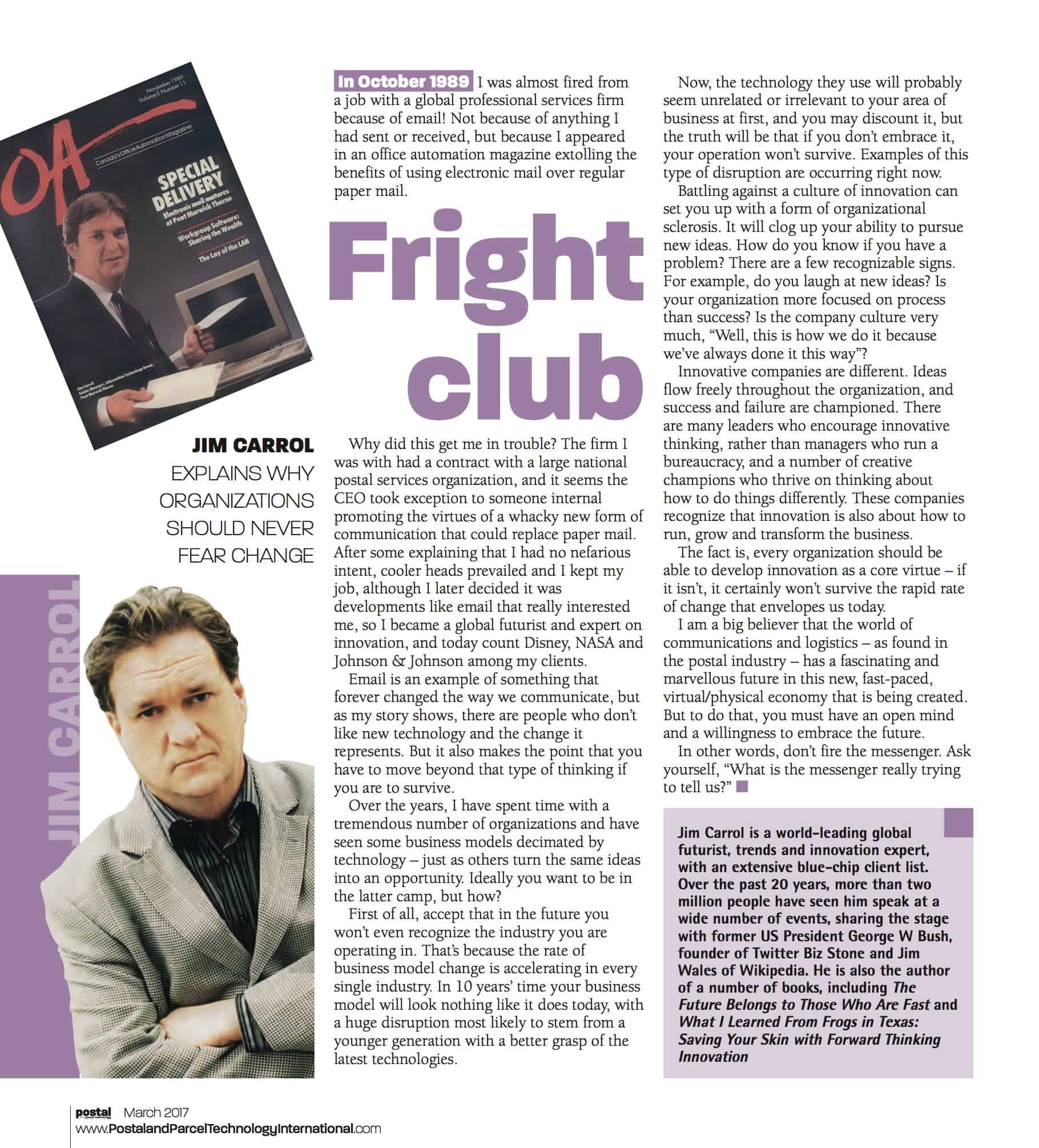
The folks at Postal and Parcel Technology Magazine approached me some months back to write an article about the future of mail in the era of technology, and particularly, e-mail.
I suggested to them that rather than looking forward, why not look to the past for valuable lessons?
Such as, how organizations seem to always react in a negative way to new technologies, new ideas and innovation?
What better way to do so than by writing about the fact that I was almost fired in 1989 (yup, 28 years ago) because of a cover story that I was featured in about electronic mail. And the fact that some folks who had a vested interest in paper mail read the article, didn’t like it, and complained. Kind of loudly. Because they didn’t like change….
The folks at Postal and Parcel loved the idea – and so we ran an article, below.
So what happened in 1989? I wasn’t fired. I ended up quitting the firm some months later, after 10 years, because the senior leadership team couldn’t comprehend my indications that something ‘big’ was happening.
For a few years, I made a lot of money actually consulting to companies on technology. Then I wrote some books (34, actually) about the Internet, and sold about 2 million books. That got me on the speaker circuit. I started speaking about the future. Companies took notice of what I was saying. More and more people and companies noticed, and I soon found myself providing guidance on the future to some fascinating organizations. One day, I found myself in front of some astronauts and astrophysicists at NASA, speaking to them about the future of space, the space industry, and the realities of innovation!
The article — click the image for a full version. Or access the PDF : [icon name=”file-pdf-o” class=”” unprefixed_class=””]. Read it below!
Fright Club
Jim Carroll Explains Why Organizations Should Never Fear Change
Postal and Parcel Technology International, March 2017
In October 1989 I was almost fired from a job with a global professional services firm because of email! Not because of anything I had sent or received, but because I appeared in an office automation magazine extolling the benefits of using electronic mail over regular paper mail.
Why did this get me in trouble? The firm I was with had a contract with a large national postal services organization, and it seems the CEO took exception to someone internal promoting the virtues of a whacky new form of communication that could replace paper mail. After some explaining that I had no nefarious intent, cooler heads prevailed and I kept my job, although I later decided it was developments like email that really interested me, so I became a global futurist and expert on innovation, and today count Disney, NASA and Johnson & Johnson among my clients.
Email is an example of something that forever changed the way we communicate, but as my story shows, there are people who don’t like new technology and the change it represents. But it also makes the point that you have to move beyond that type of thinking if you are to survive.
Over the years, I have spent time with a tremendous number of organizations and have seen some business models decimated by technology – just as others turn the same ideas into an opportunity. Ideally you want to be in the latter camp, but how?
First of all, accept that in the future you won’t even recognize the industry you are operating in. That’s because the rate of business model change is accelerating in every single industry. In 10 years’ time your business model will look nothing like it does today, with a huge disruption most likely to stem from a younger generation with a better grasp of the latest technologies.
Now, the technology they use will probably seem unrelated or irrelevant to your area of business at first, and you may discount it, but the truth will be that if you don’t embrace it, your operation won’t survive. Examples of this type of disruption are occurring right now.
Battling against a culture of innovation can set you upward this. form of organizational sclerosis. It will clog up your ability to pursue new ideas. How do you recognize if you have a problem? There are a few recognizable signs For example, do you laugh at new ideas? Is your organization more focused on process than success/ Is the company culture very much, “Well, this is how we do it because we’ve always done it this way?”
Innovative companies are different. Ideas flow freely throughout the organization, and success and failure are championed. There are many leaders who encourage innovative thinking, rather than magaers who run a bureacracracy, and a number of creative champions who thrive on thinking about how to do things differently. These companies recognize that innovation is also about how to run, grow and transform the business.
The fact is, every organization should be able to develop innovation as a core virtue – if it isn’t, it certainly won’t survive the rapid rate of change that envelopes us today.
I am a big believer that the world of communications and logistics – as found in the postal industry – has a fascinating and marvellous future in this new, fast-paced, virtual/physical economy that is being created. But to do that, you must have an open mind and a willingness to embrace the future.
In other words, don’t fire the messenger. Ask yourself, “What is the messenger really trying to tell us?






GET IN TOUCH
Jim's Facebook page
You'll find Jim's latest videos on Youtube
Mastodon. What's on Jim's mind? Check his feed!
LinkedIn - reach out to Jim for a professional connection!
Flickr! Get inspired! A massive archive of all of Jim's daily inspirational quotes!
Instagram - the home for Jim's motivational mind!